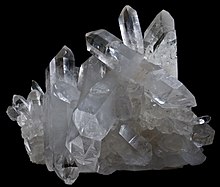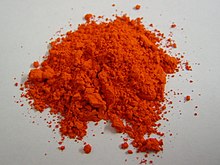Oxides



Oxides (also commonly known as oxides ; from Greek ὀξύς, oxýs, sharp, pointed, acidic) are oxygen compounds of an element in which it has the oxidation number −II. Most oxides are formed when flammable substances react with oxygen (origin of the word oxidation ): When they oxidize, they release electrons to the oxidizing agent oxygen, so that oxides are formed.
Basically, every compound of an element with oxygen is called an oxide. Oxygen- fluorine compounds are an exception . Since the oxygen in these has a positive oxidation number and the fluorine has a negative oxidation number, these compounds are not called fluorine oxides , but oxygen fluorides .
Depending on the binding partner, there are two groups of oxides in chemistry :
- Metal oxides (these are ionic ( salt-like ) or covalently bound oxides; oxides of base metals react with water to form bases and form alkalis ),
- Non-metal oxides (these are molecular, mostly volatile and react with water to form acids )
According to their stoichiometric composition, a distinction is made between monoxides, dioxides, trioxides, tetroxides, pentoxides, such as carbon monoxide, chlorine dioxide and sulfur trioxide. The majority of the earth's crust and mantle consists of oxides (mainly silicon dioxide ( quartz ) and salts derived from it, the silicates and aluminum oxide). Also water belongs to the group of oxides. Ethylene oxide is an example of an organic oxide.
Manufacturing
Oxides are made by:
- Heating of hydroxides and oxide hydrates (example: copper (II) hydroxide turns into copper (II) oxide and water vapor, rust turns into iron oxides and water vapor),
- Heating of salts with volatile anhydrides (example: burning lime / calcium carbonate to calcium oxide, heating of copper (II) nitrate to copper (II) oxide and nitrous gases)
- Reaction of elements with oxygen (oxidation in the narrower sense, formerly also known as oxygenation).
The black copper (II) oxide shown above can therefore be used, for. B. be synthesized by the following reactions :
Furthermore, the red copper (I) oxide could be converted into black copper (II) oxide by means of oxygen. Copper (II) oxide is also produced when roasting sulphidic copper ores by annealing copper (II) sulphide in air or in a stream of oxygen (by-product sulfur dioxide).
How easily a metal forms an oxide depends on the electronegativity and oxygen affinity of the element. The less noble a metal, the more violently it can generally react with oxygen and form oxides. In addition, the reactivity also depends on the passivation of an element, since with many elements a tightly adhering oxide layer prevents further reaction. The metal can only react further if this is permeable to oxygen or is removed.
Properties of the oxides
There are - classified according to their reaction with water - acidic, basic, amphoteric and indifferent oxides
- Amphoteric oxides and hydroxides have the property of being able to react acidic and basic depending on the reactant (see under acid-base reaction ). They react with acids and with bases to form salts.
- Metal oxides are salt-like (ionic), oxides of base metals react with water to form bases and lyes .
- Non-metal oxides are molecular and react with water to form acids ,
- Indifferent oxides do not react with water; these are, for example, carbon monoxide (CO), nitrous oxide N 2 O and nitrogen monoxide NO.
Oxides of noble metals are therefore often converted into hydroxides via a detour as salts for the purpose of reacting with water : Copper (II) oxide can e.g. B. in conc. Hydrochloric acid can be dissolved to form copper (II) chloride . This forms copper (II) hydroxide with sodium hydroxide solution, which, as indicated above, can be converted into copper (II) oxide by heating.
Hydroxides are flaky precipitates that often have characteristic colors (copper (II) hydroxide light blue, nickel (II) hydroxide apple green, chromium (III) hydroxide gray-green, manganese (II) hydroxide pink and turn brown in air as a result of oxidation , Cobalt (II) hydroxide blue or pink, iron (III) hydroxide rust brown, iron (II) hydroxide gray-green).
Oxide ion and hydroxide ion
The O 2− ion on which the metal oxides are based is formed during the redox reaction of the oxidizing agent oxygen with a metal . It only exists in melts and in combination with cations (in the form of salts ), but not as a free ion , because it is an extremely strong base and is thus quantitatively protonated to the hydroxide ion in aqueous solution ( acid-base reaction ) . Metal hydroxides contain the OH - ion and are mostly obtained from salt solutions and alkalis.
In non-metal oxides there is usually no oxide anion, since non-metals form a covalent bond with one another. The peroxide ion, which is similar to the oxide ion, has an oxidation number of −I instead of −II, since two oxygen atoms are connected to one another. Non-metal oxides react with water to form acids (with oxo anions such as sulfate, carbonate, etc.). They are therefore to be regarded as hydroxides of acidic character.
The binding capacity of oxygen
Oxygen is a strong oxidizing agent and forms isolable oxides with almost all elements , with the exception of the noble gases helium , neon , argon , krypton and the halogen fluorine (fluorine occupies a special position here because the oxygen compounds OF 2 , O 2 F 2 and O 4 F 2 can be represented, but because of the higher electronegativity of fluorine , these substances are not referred to as fluoroxides, but rather as oxygen fluorides ).
In addition to oxides, oxygen also forms oxo anions : Here, several oxygen atoms have bonded to one atom, which usually has the highest possible oxidation number (examples: phosphate, sulfate, chromate, permanganate, nitrate, carbonate). They usually arise when non-metal and sub-group metal oxides with a very high oxidation number react with water to form acids.
There are also oxygen-oxygen compounds such as B. in bleach hydrogen peroxide (see above). Inorganic peroxides are highly corrosive and oxidizing, organic peroxides are usually explosive.
use
Natural metal oxides serve as ores for metal extraction. The oxygen is removed from them by smelting - for example by means of carbon ( blast furnace process ) - and the pure metal is obtained.
Metal oxides were used as pigments as early as the Stone Age and were also called earth pigments.
Another application in recent times is its use as an isolator in information technology .
Individual oxides and other oxygen compounds
Known oxides
- Aluminum oxide (a white, slightly basic solid)
- Lead oxide (there is a yellow and a black-brown oxide as well as a mixed oxide called red lead )
- Calcium oxide ( burnt lime , corrosive, strongly basic)
- Dihydrogen (mono) oxide, dihydrogen monoxide ( water )
- Iron oxides such as iron (III) oxide or rust
- Carbon dioxide (forms carbonic acid with water )
- Carbon monoxide (toxic, colorless and odorless, flammable)
- Copper oxide (there is red copper (I) oxide and black copper (II) oxide )
- Magnesium oxide (magnesia, a white, basic powder)
- Phosphorus pentoxide (forms phosphoric acid with water )
- Sulfur dioxide (acidic odor, soluble in water with an acidic reaction)
- Sulfur trioxide (forms sulfuric acid with water )
- Silicon dioxide (quartz, may combine with water to form silica)
- Nitrogen oxides (mostly colored brown by nitrogen dioxide, may react further to nitric acid)
- Zinc oxide (an earthy white powder that turns pale yellow when heated)
Oxygen compounds with oxygen in other oxidation states are:
- Hyperoxides (−½),
- Ozonides (- 1 / 3 )
- Peroxides (−1) and
- Salts with the dioxygenyl cation O 2 + (+ ½).
See also
Individual evidence
- ↑ a b c Entry on oxides. In: Römpp Online . Georg Thieme Verlag, accessed on June 24, 2017.
- ↑ a b Brockhaus ABC chemistry . VEB FA Brockhaus Verlag, Leipzig 1965, p. 1004.
- ^ Theodore L. Brown, H. Eugene LeMay, Bruce E. Bursten: Chemistry: Studying compact . Pearson Studium, 2011, 10th edition, ISBN 3868941223 , p. 273.
- ^ Gerhard Jokisch, Bruno Schütze, Werner Städtler in: Author collective: Das Grundwissen des Ingenieurs , VEB Fachbuchverlag, Leipzig 1968, pp. 991–1163, p. 1002.
- ^ Brockhaus ABC chemistry . VEB FA Brockhaus Verlag, Leipzig 1965, p. 1078.






